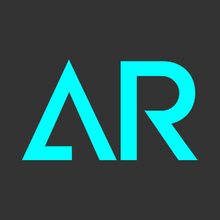ARToolKit is an open-source computer tracking library for creation of strong augmented reality applications that overlay virtual imagery on the real world. Currently, it is maintained as an open-source project hosted on GitHub.[2]
 | |
| Original author(s) | Hirokazu Kato, Mark Billinghurst, Ivan Poupyrev |
|---|---|
| Initial release | 1999 |
| Stable release | 1.1.9
/ May 18, 2023[1] |
| Repository | github |
| Written in | C, C++ |
| Operating system | Cross-platform: Linux, Windows, OS X, iOS, Android |
| Type | 3D graphics |
| License | GNU Lesser General Public License v3.0 with special exemptions. |
| Website | http://www.artoolkitx.org/, http://www.hitl.washington.edu/artoolkit/ |
Overview
editIn order to create strong augmented reality, ARToolKit uses video tracking capabilities that calculate the real camera position and orientation relative to square physical markers or natural feature markers in real time. Once the real camera position is known a virtual camera can be positioned at the same point and 3D computer graphics models drawn exactly overlaid on the real marker. So ARToolKit solves two of the key problems in Augmented Reality; viewpoint tracking and virtual object interaction.
ARToolKit was originally developed by Hirokazu Kato of Nara Institute of Science and Technology in 1999[3] and was released by the University of Washington HIT Lab. In 2001 ARToolWorks was incorporated, and v1.0 of the open-source version of ARToolKit was released through the HIT Lab. ARToolKit was one of the first AR SDKs for mobile, seen running first on Symbian in 2005,[4] then iOS with the iPhone 3G in 2008,[5] and finally Android as early as 2010[6] with a professional version by ARToolWorks later in 2011.
ARToolKit was acquired by DAQRI and re-released open-source starting at version 5.2 on May 13, 2015,[7] including all of the features that were previously only available in the professional licensed version. Among these features are mobile support and natural feature tracking.
ARToolKitPlus (sometimes written "ARToolKit+") was intended to be a successor to the ARToolKit library that was optimized for mobile devices. ARToolKit was originally written in C; ARToolKit+ was ported it to C++ to make it easier to maintain, and has a new class-based (C++) API that is intended to be easier-to-use.[8][9][10][11]
Ben Vaughan and Phil Lamb, the former CEO and CTO of ARToolworks, created artoolkitX to ensure that the software is developed and maintained and the ARToolKit community continues to be supported. artoolkitX was initially supported by Realmax Inc, a Chinese AR company that develops AR hardware and software.[12]
Features
edit- Single-camera or stereo-camera (camera position/orientation tracking).
- Tracking of simple black squares (any square marker patterns).
- Tracking of planar images (natural feature markers).
- Camera calibration, optical stereo calibration, square marker generation, and natural feature marker generation utilities.
- Plugins for Unity and OpenSceneGraph.
- Optical head-mounted display support.
- Free and open source software.
- Fast enough for real time AR applications.
Operating systems
editThe current version of ARToolKit supports Microsoft Windows, Mac OS X, Linux, iOS, and Android platforms. Other versions of ARToolKit have also been ported to Symbian, and Windows Phone to support mobile AR applications.
ARToolKit is also available as a plugin for the Unity game engine for example to align a virtual camera within Unity with a real-world camera relative to a tracked marker target and taking care of communicating with the camera. The plugin supports Unity on OS X, Unity on Windows, Unity on Android, and Unity on iOS.[13]
See also
editReferences
edit- ^ "Releases · artoolkitx/Artoolkitx". GitHub.
- ^ ARToolKit GitHub page.
- ^ Kato, H., Billinghurst, M. "Marker tracking and hmd calibration for a video-based augmented reality conferencing system.", In Proceedings of the 2nd IEEE and ACM International Workshop on Augmented Reality (IWAR 99), October 1999. [1]
- ^ "Project page for ARToolKit on Symbian". Archived from the original on 2016-03-03. Retrieved 2015-06-18.
- ^ ARToolKit running on an iPhone 3G in 2008
- ^ ARToolKit running on a Google Android G1 in 2010.
- ^ DAQRI Acquires AR Pioneer ARToolworks
- ^ Daniel Wagner; Dieter Schmalstieg. "ARToolKitPlus for Pose Tracking on Mobile Devices (2007)". "ARToolKitPlus for Pose Tracking on Mobile Devices". 2007.
- ^ "v4r_artoolkitplus".
- ^ "ARToolKitPlus".
- ^ "Differences between ARToolkit and ARToolkitPlus"
- ^ "artoolkitX web site". Archived from the original on 3 May 2018. Retrieved 3 May 2018.
{{cite web}}: CS1 maint: bot: original URL status unknown (link) - ^ "ARToolKit for Unity". GitHub. Retrieved 2023-06-07.
External links
edit- ARToolKitX Homepage
- DAQRI ARToolKit Homepage
- ARToolKit Documentation
- ARToolKit Forums
- Project page at GitHub
- HIT Lab ARToolkit
- Interactive Media Design Lab.
- Old project page at SourceForge.net
- Project page at Launchpad
- HIT Lab NZ Web forum
- mgldev.scripps.edu Archived 2017-12-06 at the Wayback Machine python binding of ARToolKit
- NyARToolKit (ARToolKit Java Edition)